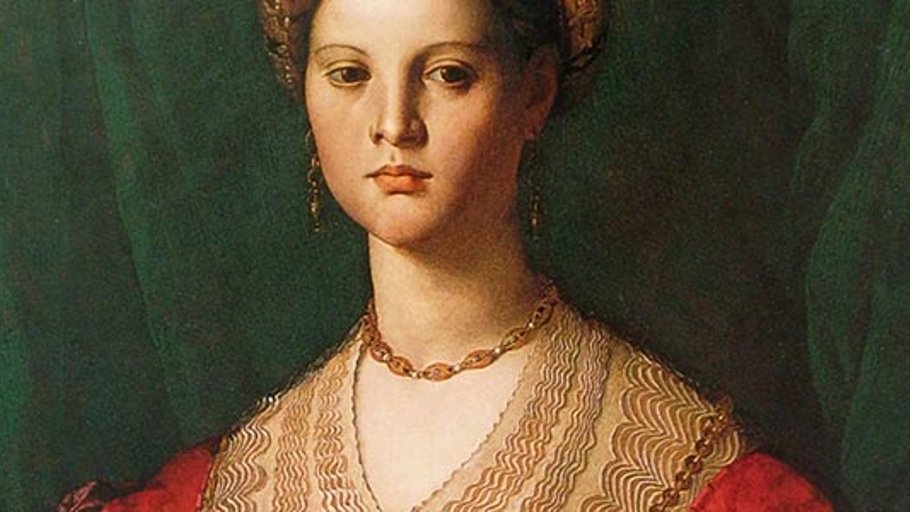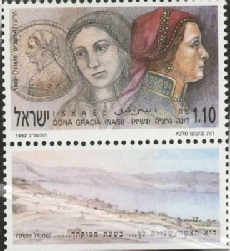 Iran’s Attack on Israel
Iran’s Attack on Israel


9 min read
Gracia Nasi defied the Spanish Inquisition to ferry thousands of Jews to safety.
Dona Gracia Nasi was a great Jewish hero. For decades she ran an underground railroad for Jews fleeing the Spanish Inquisition and single-handedly supported Jewish communities in Italy, Turkey and Israel. Praised during her lifetime as “the heart of her people”, Dona Gracia Nasi’s story is hardly remembered today. That should change; her remarkable story deserves to be known.
She was born into a secret Jewish family in Portugal in 1510 and given the royal-sounding name of Beatrice de Luna as her legal name – and Gracia Nasi as her secret Jewish name.
Gracia’s family were merchants who likely had fled the Spanish Inquisition in 1492. When Jews were expelled from Portugal three years later, many decided to stay, becoming “Conversos” or supposed converts to Christianity in public, but maintaining Jewish lives in private. The Portuguese authorities were more lenient to these secret Jews than their counterparts in Spain, and Gracia’s family were pillars of the secret Jewish community there. In fact, their hidden last name Nasi, meaning “Prince”, indicates they were long-standing community leaders. While maintaining an outward appearance of being Christian, the family observed Shabbat, avoided non-kosher foods, and studied Jewish texts in secret.
At the age of 18, Gracia married Francisco Mendes, another secret Jew, and together they built up a large trading company. They had one daughter whom they gave two names: Brianda as a non-Jewish name, and Reyna as a secret name. Reyna means queen in Spanish and might recall the common Jewish name Malka, which means queen in Hebrew. Francisco died in 1536, after eight years of marriage. That same year, the Portuguese authorities began to crack down on secret Jews. They set up a Holy Office of the Inquisition, modeled after Spain’s fearsome religious police. Many of Portugal’s secret Jews fled, Gracia and her young daughter included.
 An Israeli stamp commemorating Gracia, with image of Tiberias below
An Israeli stamp commemorating Gracia, with image of Tiberias below
The pair settled in Antwerp which was more tolerant of Jewish practice and where Gracia had many relatives. She went into business with a brother-in-law, but she longed to move somewhere where she could live completely openly as a Jew. As an upper class businesswoman in Flanders, Gracia knew it would be impossible to run a large business if she openly professed her Jewish faith. Gracia and her brother-in-law discussed moving to the German lands to the south where communities of Jews lived freely. They set a goal of moving within a year. Sadly, Gracia’s brother-in-law died suddenly, making her the sole surviving partner in a large trading company, putting Gracia’s plans to move on hold.
Gracia used her extensive business contacts to help other Jews escape.
Though she couldn’t live openly as a Jew herself, Gracia used her extensive business contacts to help other Jews escape to cities where they could live Jewish lives. She helped secret Jews escape from Portugal and Spain, and to make the difficulty journey over the Alps into Italy or into the Balkans. It was more difficult to help these Jews escape with some of their property and wealth to help them start their new lives.
Gracia’s extensive business contacts hid a network of escape routes throughout Europe. While she traded spices and gems, her business agents also ferried secret Jews across borders along with this merchandise. One popular route was for Jews to board Gracia’s ships in Spain and Portugal, bound for England. When the ships docked in Southampton or Plymouth, one of Gracia’s London agents, a man named Christopher Fernandes, was instructed to board the ships and let the hidden Jews know whether it was safe to stay on board for the next leg of the journey, to the Netherlands. Because Jews were banned from England at the time, the journey was a hazardous one.
 Image of Dona Gracia looking towards Tiberias, symbolizing her determination to create a better future for the Jewish people.
Image of Dona Gracia looking towards Tiberias, symbolizing her determination to create a better future for the Jewish people.
Another of Gracia’s London agents was Antonio de la Ronha, a learned Jew who was related to her. He was tasked with helping Jewish refugees recover property they’d been forced to leave behind.
Once in the Netherlands, many secret Jews found employment in Gracia’s warehouses and businesses until they could be dispatched to safety further south to Italy or Turkey. Gracia’s agents instructed the fleeing Jews on which roads to use and in which inns it was safe to stay. They relied on a network of sympathetic allies. In Venice, a non-Jewish printer named Daniel Bomberg, who specialized in printing Hebrew books, received the property of fleeing Jews and returned it to their owners once they’d made it to the relative safety of Italy.
Writing in 1946, the British historian Cecil Roth noted that Gracia was the “brains behind the whole of this elaborate organization” and that “There is nothing similar in Jewish history, or perhaps in any history, until our own day and the organization of the ‘underground railway’ for saving Jews from the hell of Nazi and post-Nazi Europe and securing their entry…to the Land of Israel.”
 Emperor Charles V
Emperor Charles V
In Antwerp, Gracia’s vast wealth attracted unwanted attention from kings and princes. Emperor Charles V wanted Gracia’s daughter to marry one of his courtiers and seize the family’s wealth. Gracia said she wished to visit a spa in France and fled with her daughter and as much property as she could carry. From France, she travelled on to Italy, settling in Venice where she re-established her trading business.
Even though Jews lived openly in Venice – confined to a dreary island called the Ghetto – Gracia was not able to reveal her Jewishness publicly. To do so would have meant an end to her business dealings. In fact, it appears Gracia was arrested and held in prison briefly in Venice after she was accused of being a secret Jew. She began a clandestine plan to transfer her wealth to Turkey, with an eye to eventually living there. Turkey at the time was welcoming the Jews who’d been forced out of Europe. Sultan Bajazet II famously declared that he couldn’t understand the motives of King Ferdinand of Spain, who’d decreed that all Jews leave Spain in 1492. “How can you call this Ferdinand ‘wise’ – he who has impoverished his dominions in order to enrich mine?” the Sultan asked as industrious, educated Jews left Europe for Ottoman lands.
Gracia’s life in Venice was precarious. In 1550 Venetian authorities started prosecuting secret Jews and Gracia, along with her sister-in-law, daughter and niece, fled to the Italian town of Ferrara. There, for the first time in her life, she publicly declared her Jewishness, using her name Gracia. She changed her last name to her family’s previous Hebrew surname of Nasi. When her nephew Joao visited Gracia, he adopted the name Nasi too and changed his first name to Samuel. In Ferrara, Gracia supported local Jewish scholars and paid for the first translation of the Torah into Spanish.
This peace and happiness was short-lived. In 1551, plague broke out in Ferrara. City officials blamed Jews and forced Jews to leave the town. Gracia decided the time had come. She set sail for Constantinople, in the heart of the Ottoman Empire. There, she set up a fine household, again living openly and proudly as a Jew. She continued to run her trading empire with their secret routes ferrying Jews to freedom, but for the first time Gracia was able to publicly support Jews and Jewish organizations as well.
Each day, 80 poor people entered her grand palace to receive free meals. Gracia paid to redeem Jewish slaves who were seized by pirates. When Turkey experienced a bitterly cold winter in 1567, she paid to help the empire’s poor Jews afford heat and clothes. She supported hospitals, charities, schools and synagogues throughout the Ottoman lands.
One of Gracia’s favorite projects was a synagogue and yeshiva she established in the heart of Constantinople, which was known as “the Synagogue of the Senora”. Previously, local tradition dictated that Constantinople’s Jews always prayed in the one synagogue to which their families belonged. Gracia’s synagogue was different: it was open to all Jews, welcoming everyone whether member or not.
 Izmir’s Senora Shul today
Izmir’s Senora Shul today
In 1559, Gracia established a synagogue in Salonika, in Greece, a city in which many secret Jews from Spain were finding refuge. Known as the “Gracia” synagogue, this too was specifically open to all Jews, whether members or not. She also established a kollel, or rabbinic academy, in Salonika, where the city’s rabbis and scholars could take turns studying Jewish texts full time.
Perhaps Gracia’s most ambitious project was supporting the Jewish community in Israel.
Perhaps Gracia’s most ambitious project was supporting the Jewish community in Israel. She petitioned the Sultan for permission to resettle Spanish Jews in Tiberias, an ancient city in the north of Israel, and he agreed. Gracia backed the venture and built a thriving Jewish settlement there, as well as supporting Jews elsewhere in the region. She had a grand house built for herself in Tiberias and petitioned the Sultan for permission to go to the Holy Land.
First, Gracia had a promise to keep. Years before, she’d promised her husband Francisco that she’d do everything in her power to see he was buried in Israel. Now, with great difficulty, she had his body removed from the church graveyard in Lisbon where it was interred and brought to Israel, where he was reburied in Tiberias.
Sadly, Gracia never had the chance to follow him there. She grew sick and withdrew from public life, living in Constantinople in old age in precarious health. She died in about the year 1569, one of the most beloved figures in the entire Jewish world.
Tributes were delivered to Gracia the Nasi throughout Europe and the Middle East. One of the most famous was a poem written by the great Jewish poet Sa’adiah Longo, who had fled the Spanish Inquisition as a child and moved to Salonika with his family, where he witnessed Gracia’s generosity and help for her fellow Jews firsthand. In his ode “Dona Gracia of the House of Nasi” he compares Gracia’s passing to some of the major calamities in Jewish history. She “straightened the path in the wilderness...the passage to an awesome God,” he recalled. That passageway that Gracia Nasi prepared allowed unknown thousands of Jews to escape persecution and death at the hands of the Inquisition and build new lives in safety. Her heroism deserves to be better known today.
Books for further reading:

How stupid/narrow minded the leaders of Spain/Portugal were! I read that Spain's
banking system collapsed once the Jews were expelled. A very brave/smart and determined woman. The world has a very complicated history. Now I learn that Turkey some time in history was hospitable to the Jews!
I wish the "radical/leftest Jews in this country (US) would wake up!
Wonderful to learn about this wonderful person. I will think of her as a queen, as Malkah. She has a true Jewish soul, a Djudjyo neshumah, a Yiddische neshumah.